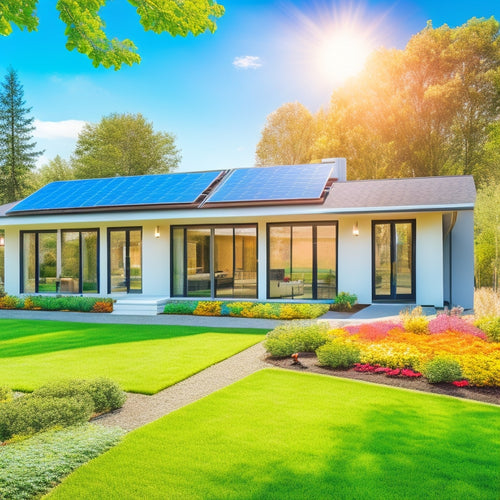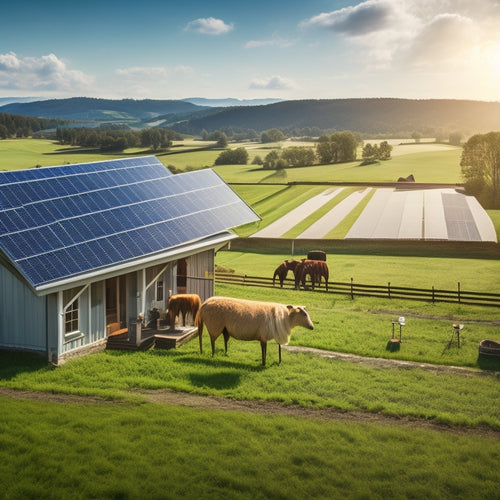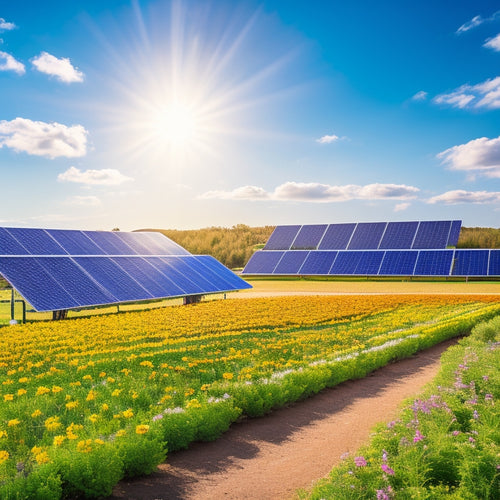
Different Sizes of Solar Panels for Home and Business
Share
You have various solar panel sizes to choose from, ranging from compact units for small homes to large, high-efficiency panels for commercial and industrial applications. Residential solar panels typically measure 39-41 inches wide and 65-67 inches long, having a mass of 35-40 pounds, with an average efficiency of 18-20%. Commercial solar panels are larger, with dimensions of 41-42 inches wide and 67-72 inches long, having a mass of 40-45 pounds, and an average efficiency of 19-21%. Larger panels, up to 44-46 inches wide, offer higher efficiency rates of 20% or more, suitable for expansive industrial installations. Understanding the differences in size, mass, and efficiency will help you find the perfect fit for your energy needs, and exploring further will reveal even more options customized to your specific requirements.
Key Takeaways
- Residential solar panels typically require 15-25 panels, with standard dimensions of 39-41 inches wide and 65-67 inches long, weighing 35-40 pounds each.
- Commercial solar panels are larger, with dimensions of 41-42 inches wide and 67-72 inches long, weighing 40-45 pounds, and offering higher efficiency rates.
- Industrial roof spaces can accommodate large solar installations, with capacities of up to 1,000 kilowatts, requiring strategic panel placement and design considerations.
- Custom solar panel solutions cater to unique design features and energy needs, with adaptability for irregularly shaped roofs and limited space challenges.
- Bifacial solar panels, with dimensions of 42-44 inches wide and 67-72 inches long, offer enhanced energy production by capturing sunlight from both sides.
Residential Solar Panel Sizes
Most homes require between 15 and 25 solar panels to meet their energy needs, but the exact number depends on several factors, including your energy consumption, roof size, and local building codes.
When selecting the right solar panel size for your residential installation, you'll need to take into account solar panel efficiency, which affects how much energy each panel produces per hour of sunlight. Higher-efficiency panels require less space to generate the same amount of energy, but they're often more expensive.
You'll also need to take into account installation factors, such as the orientation and tilt of your roof, which impact the panel's energy output.
Additionally, you'll need to verify that your roof can support the weight of the panels and that they're installed at a safe distance from obstructions like vents and skylights.
Commercial Solar Panel Dimensions
When you're looking to install commercial solar panels, you'll need to contemplate the large-scale energy production requirements of your business.
With industrial roof space, you have the opportunity to maximize your energy output, and commercial solar panel dimensions are designed to do just that.
You'll want to choose panels that can efficiently utilize the sun's energy to power your operations.
Large-Scale Energy Production
As you scale up your energy production, you're likely to find yourself dealing with larger solar panel systems, which is where commercial solar panel dimensions come into play. To maximize solar efficiency, you'll need to take into account the layout and configuration of your panels to optimize energy output. This often involves using larger panels with higher wattage outputs to reduce the overall number of panels required.
When it comes to large-scale energy production, energy storage becomes a critical component. You'll need to examine battery solutions that can handle the increased energy output and provide a stable supply of power. This may involve installing multiple battery banks or using advanced energy storage systems that can manage the fluctuating energy output of your solar panels.
In large-scale energy production, every detail matters. From the type of inverters used to the cabling and electrical infrastructure, each component must be carefully selected to guarantee maximum efficiency and reliability.
Industrial Roof Space
You're likely familiar with the concept of maximizing roof space for energy production, but when it comes to industrial roof spaces, the stakes are higher and the opportunities greater.
With vast expanses of rooftop real estate, industrial facilities can accommodate large-scale solar installations that generate significant amounts of power. To fully utilize this potential, commercial solar panel dimensions are vital.
Industrial design plays an important role in roof optimization, as it enables the efficient placement of solar panels to maximize energy production. By strategically positioning panels to minimize shading and enhance sun exposure, you can increase energy yields while reducing installation costs.
For instance, a well-designed industrial solar array can accommodate up to 1,000 kilowatts of power, sufficient to meet the energy demands of a large manufacturing facility.
To achieve the best roof optimization, it's important to assess your industrial roof space's unique characteristics, including its size, shape, and structural integrity.
Small Solar Panels for Homes
Energy independence beckons with the installation of small solar panels for homes, an attractive option for homeowners seeking to reduce their reliance on traditional energy sources.
These compact designs offer a range of benefits, making them an ideal choice for residential properties.
Here are some key advantages of small solar panels for homes:
-
Portability: Small solar panels are lightweight and easy to transport, making them perfect for homes with limited roof space or for those who want to take their solar panels with them when they move.
-
Easy Installation: Compact designs simplify the installation process, reducing the time and cost associated with larger systems.
-
Flexibility: Small solar panels can be easily integrated into existing electrical systems, allowing you to start generating power immediately.
- Cost-Effective: Smaller systems require less material and labor, making them a more affordable option for homeowners on a budget.
Large Solar Panels for Business
Several hundred businesses worldwide have already harnessed the power of large solar panels to greatly reduce their operating costs and carbon footprint.
As you consider joining their ranks, it's crucial to understand the benefits and installation considerations of large solar panels for your business.
Large solar panels, typically ranging from 300 to 400 watts, offer higher solar panel efficiency, translating to more power per unit area. This means you can generate more electricity while minimizing the required rooftop or land space.
When selecting large solar panels, look for high-efficiency models with a rating of 20% or higher to maximize your energy output.
During installation, consider the structural integrity of your building and confirm that it can support the weight of the panels.
You'll also need to assess the shading and obstruction patterns on your rooftop or land to optimize panel placement and angle.
Standard Solar Panel Measurements
When planning your solar panel installation, understanding standard solar panel measurements is essential to guarantee a seamless integration with your rooftop or land space.
You want to confirm that the solar panels you choose fit perfectly, allowing for maximum solar panel efficiency and minimizing installation considerations.
Standard solar panel measurements typically range from 39 inches to 41 inches in width and 65 inches to 67 inches in length.
Here are some common standard solar panel sizes:
- 60-cell solar panels: 39" x 65" (Ideal for residential installations)
- 72-cell solar panels: 41" x 67" (Suitable for commercial and industrial applications)
- 120-cell solar panels: 41" x 82" (Used for large-scale commercial and utility projects)
- 144-cell solar panels: 43" x 87" (Designed for high-power output and large-scale installations)
These standard measurements allow for easy installation, maintenance, and replacement of solar panels.
Custom Solar Panel Solutions
How will you accommodate unique design features or unconventional spaces in your solar panel installation? Custom solar panel solutions are the answer. These personalized installations cater to your specific energy needs, ensuring peak energy harvesting even in challenging environments.
By opting for customized energy solutions, you can overcome obstacles like irregularly shaped roofs, limited space, or design constraints.
Custom solar panel solutions involve designing and engineering solar panels that fit your unique requirements. This might include panels with non-standard dimensions, custom mounting systems, or innovative installation techniques.
The result is a personalized installation that seamlessly integrates with your property, providing superior energy output while maintaining aesthetics.
With custom solar panel solutions, you can access the full potential of your space, no matter how complex or unconventional it may be.
By utilizing advanced technology and expert engineering, you can leverage the power of the sun like never before.
Get ready to experience the benefits of customized energy, personalized to your specific needs and designed to deliver maximum results.
Solar Panel Size Comparison
You've opted for custom solar panel solutions to cater to your unique energy needs.
Now, it's crucial to compare different solar panel sizes to determine the most suitable option for your home or business.
When selecting the ideal solar panel size, you'll need to evaluate factors such as solar efficiency, panel weight, and overall energy output.
Here are some key differences in solar panel sizes:
-
Standard Residential Panels: 39-41 inches wide, 65-67 inches long, and 35-40 pounds, with an average efficiency of 18-20%.
-
Commercial Solar Panels: 41-42 inches wide, 67-72 inches long, and 40-45 pounds, with an average efficiency of 19-21%.
-
Large Format Solar Panels: 44-46 inches wide, 72-77 inches long, and 45-50 pounds, with an average efficiency of 20-22%.
- Bifacial Solar Panels: 42-44 inches wide, 67-72 inches long, and 40-45 pounds, with an average efficiency of 20-22%.
Frequently Asked Questions
Can I Mix and Match Different Solar Panel Sizes on My Roof?
You can mix and match different solar panel sizes, but guarantee compatibility by checking voltage and current ratings. Consider your roof space, too, as varying sizes may affect layout and overall energy output.
Are More Efficient Solar Panels Worth the Extra Cost?
When assessing the cost of more efficient solar panels, you're fundamentally doing a cost-benefit analysis. Ask yourself: does the increased energy efficiency justify the extra cost? If it's vital for you to maximize energy production, then yes, it's worth the investment.
Do Solar Panels Come With a Warranty or Guarantee?
When you invest in solar panels, you'll typically receive a warranty covering defects and a performance guarantee ensuring ideal energy output. You'll want to review the terms, as they vary between manufacturers, but expect 25-year warranties and guarantees ranging from 80% to 90% performance after 25 years.
Can I Install Solar Panels Myself to Save Money?
You can attempt a DIY installation to save money, but it's not recommended; improper installation can void warranties, compromise system performance, and even pose safety risks, outweighing any potential cost savings.
Will Solar Panels Still Work During a Power Outage?
When the grid goes dark, you're a captain without a rudder, but solar panels can be your guide. During a power outage, your solar panel functionality won't be affected, as long as you have a battery backup system, providing you with reliable power outage solutions.
Conclusion
As you consider investing in solar energy, remember that the right panel size depends on your specific needs. Did you know that the average American uses 900 kilowatt-hours of electricity per month, which can be powered by just 7-10 solar panels? With the various sizes and custom solutions available, you can utilize the power of the sun to reduce your energy bills and carbon footprint. By choosing the perfect fit, you'll be on your way to a more sustainable future.
Related Posts
-

How Solar Panels Increase Property Value
Installing solar panels considerably increases your property value by improving energy efficiency and attracting eco-...
-

Solar Power Systems for Rural Properties
Solar power systems offer a reliable and efficient energy solution for rural properties, allowing you to gain energy ...
-

High-Performance Solar Solutions for Sustainable Living
High-performance solar solutions are your gateway to sustainable living, maximizing energy efficiency while considera...


